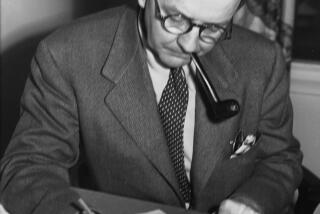Review: How much did Robert Lowell’s manic-depression affect his poetry? A new biography tries to find the answer
We love the legend of the mad genius, the artist whose unchained mind offers the clearest view of the truth of our world. There is plenty of indication that many of history’s great poets and prophets may have been clinically insane. This is the myth Kay Redfield Jamison wants to debunk. Jamison, one of the major researchers and chroniclers of bipolar disorders of the last quarter century, is deeply interested in the relationship between insanity and vision. In her critical biography “Robert Lowell, Setting the River on Fire,” she has found perhaps her ideal subject, one of the American midcentury’s most important poets, the major figure of the confessional movement, who was also famously bipolar.
Lowell suffered mightily from manic-depressive illness; yet he overcame the hobbling breakdowns he suffered time and again between the ’50s and the ’70s to make some of America’s greatest poetry. Jamison draws on previously inaccessible sources, including Lowell’s medical records and a late-life journal. Lowell’s bouts of manic-depression and his ability to write despite, through and about them, are a pillar of his legacy. For Jamison, Lowell’s life is a near perfect proof of “a link between mental illness, especially bipolar disorders, and creativity.”
Not only has Jamison studied bipolar illness for decades as a clinical psychologist but she herself also suffers from it, and has written movingly and artfully about her own descents into insanity in “An Unquiet Mind” (1995), among other books. A lucid and careful writer capable of translating clinical concepts into general interest prose, Jamison has focused much of her work on the relationship between manic-depressive illness — “madness,” as she calls it more casually — and artistic inspiration. Her books, especially “Touched by Fire,” look at length at artists and writers such as Vincent van Gogh, Lord Byron and Virginia Woolf, delving into the ways madness may have affected their art.
This book feels very much like a labor of love, even obsession, and perhaps projection: Jamison deeply empathizes with Lowell, and clearly treasures his poetry, which she quotes frequently and at length. Her analytical eye may at times be blinded by her love and admiration for her subject, and yet this is also the best book so far about one of our most polarizing contemporary literary figures.
Jamison finds rich examples from Lowell’s life to illustrate how mania influenced and enabled his poetry.
Lowell is, in many ways, a difficult writer to approach right now. While his work has seen a resurgence over the last decade — due to the publication of his long-awaited “Collected Poems” in 2003 (a short collection of selected poems is being published in conjunction with this book) — his star had faded considerably between his death in 1977 and the turn of the millennium. That’s because Lowell came to represent all the things our multicultural contemporary literary conversation has tried to overcome. He was descended from Mayflower pilgrims; his family has a Massachusetts town named after one of its patriarchs; he was wealthy, wildly entitled and enabled greatly in his career by his privilege. He could also, in his manic phases, be cruel to his loved ones, especially his three wives, writers Jean Stafford, Elizabeth Hardwick and Caroline Blackwood.
Robert Traill Spence Lowell IV, know as Cal (short for Caligula) to his friends, was born in 1917 to a minor branch of one of America’s oldest prominent families. Ensconced in Boston’s high society from childhood, Lowell was a volatile and sometimes violent youth — Jamison recalls, for example, his childhood obsessions with snakes and Napoleon. He had already committed himself to poetry by the time he enrolled at — and transferred from — Harvard. He then attended Kenyon, where he studied with poets Allan Tate and John Crowe Ransom.
Lowell won the 1947 Pulitzer Prize for his second book, “Lord Weary’s Castle,” and won it again for “The Dolphin” in 1974. In between, he published “Life Studies” in 1959, one of the transformative books of midcentury poetry, and despite sometimes annual hospitalizations for mania, lived at the center of American literary life over four decades. He died of a heart attack in 1977, in a cab on his way to return to Hardwick, having left Blackwood.
This is the third major biography of Lowell. The first, “Robert Lowell: A Biography” (1982) by Ian Hamilton, is perhaps too harsh and judgmental. The second, “Lost Puritan” (1994) by Paul Mariani, feels hazy and distant. In both books, the subject seems more invented than recorded, the sum of his attributes rather than their source.
Jamison is the first biographer who isn’t afraid of Lowell; neither tarnishing his monumental reputation nor admitting that an identification with his insanity intimidates her. Perhaps the time that has passed since his death and the resurgence of his reputation accounts for the former; Jamison’s own struggles with madness certainly account for the latter. While at times her identification with her subject — Lowell, it becomes clear, is a kind of hero to Jamison — clouds her critical vision, Jamison is the first biographer to succeed at humanizing this larger-than-life figure.
She is at her best when cleaving close to Lowell’s life for her analysis. In the first half of the book, which contains most of the straight-ahead biography, Jamison finds rich examples from Lowell’s life to illustrate how mania influenced and enabled his poetry.
By the last third of the book, when she’s deep into theoretical speculation about the ties between mania and inspiration, as well as the centuries-long recorded history of the illness, Jamison begins to repeat herself, making puffy, vague assertions, such as that after a breakdown, “One can enter into life again; less well can one reenter the fray of life.” What is the difference between “life” and “the fray of life”? Jamison seems to intuit a deeper and more mysterious link between mania and inspiration than she is finally able to penetrate or describe.
I fear — and maybe hope — that what Jamison proves is that science cannot explain how and why art is made.
Lowell was racked by nearly annual breakdowns and hospitalizations beginning in the ’50s, but found a few years of late-life peace thanks to lithium, which stabilized his mania from the end of the ’60s until the mid-’70s. Then, in part due to Blackwood’s skepticism about psychiatric treatments, he was less consistent about taking it.
The drug therapy coincides with a strange and controversial period in Lowell’s writing, during which he obsessively wrote nothing but scandalously autobiographical sonnets, beginning with 1969’s “Notebook.” He then radically revised and added to the poems from that book, splintering it into two additional collections, “For Lizzie and Harriet” (about the end of his marriage to Hardwick) and “History” (both 1973). In addition to those two books, also in 1973, he published “The Dolphin,” about the rise and fall of his marriage to Blackwood, in which he infamously recast actual letters from Hardwick into sonnets. Some critics called this glut of sonnets unforgivable; others praised it as an extended masterpiece. It’s certainly notable that he obsessively dedicated himself to a single poetic form, a volcanic free verse sonnet, only during the years he was stabilized on lithium.
Nonetheless, writes Jamison, “No one, least of all Lowell, could say whether lithium had made ‘Notebook’ possible and remarkable, or if it had kept better work from emerging.”
This exemplifies the one major trouble at the heart of this otherwise wonderful book, and the issue is with the impossible task Jamison has set herself — to explain the source of art. I fear — and maybe hope — that what Jamison proves is that science cannot explain how and why art is made.
And yet, one is left without a doubt that Lowell’s lifelong struggles with manic-depression marked his poetry. Lowell wrote with extraordinary grace and invention about his bouts of mania, his hospital stays, and the ramifications of his manic cruelty and affairs on his friends and loved ones. Jamison also shows the extent to which the cycles of manic-depressive illness grew to be an essential part of Lowell’s writing practice. She offers many accounts of how he drafted poems during manic phases — when mania pushed his mind toward wild associative leaps — and revised them during the depressions that followed his comedowns and hospitalizations, when he was anchored, analytical and riddled with guilt. Perhaps Lowell’s most amazing personal quality was not his poetic brilliance, but his dogged determination to repair himself and his relationships after each of his 20 breakdowns and return to his worldly life and his writing, bringing back insight and imagery from his depths.
But the deep mystery of the source of art remains. And perhaps this is why, after all, humanity has required art across its millenniums. As Wallace Stevens says, “The poem must resist the intelligence almost successfully,” a maxim that relegates — or even elevates — art to the realm of intuition, dream, hope, even prophesy, where art itself may be our only compass.
Teicher is the editor of “Once and for All: The Best of Delmore Schwartz.” His next book of poetry, “The Trembling Answers,” will be published in April.
“Robert Lowell, Setting the River on Fire: A Study of Genius, Mania, and Character”
Kay Redfield Jamison
Knopf: 560 pp., $29.95
More to Read
Sign up for our Book Club newsletter
Get the latest news, events and more from the Los Angeles Times Book Club, and help us get L.A. reading and talking.
You may occasionally receive promotional content from the Los Angeles Times.







